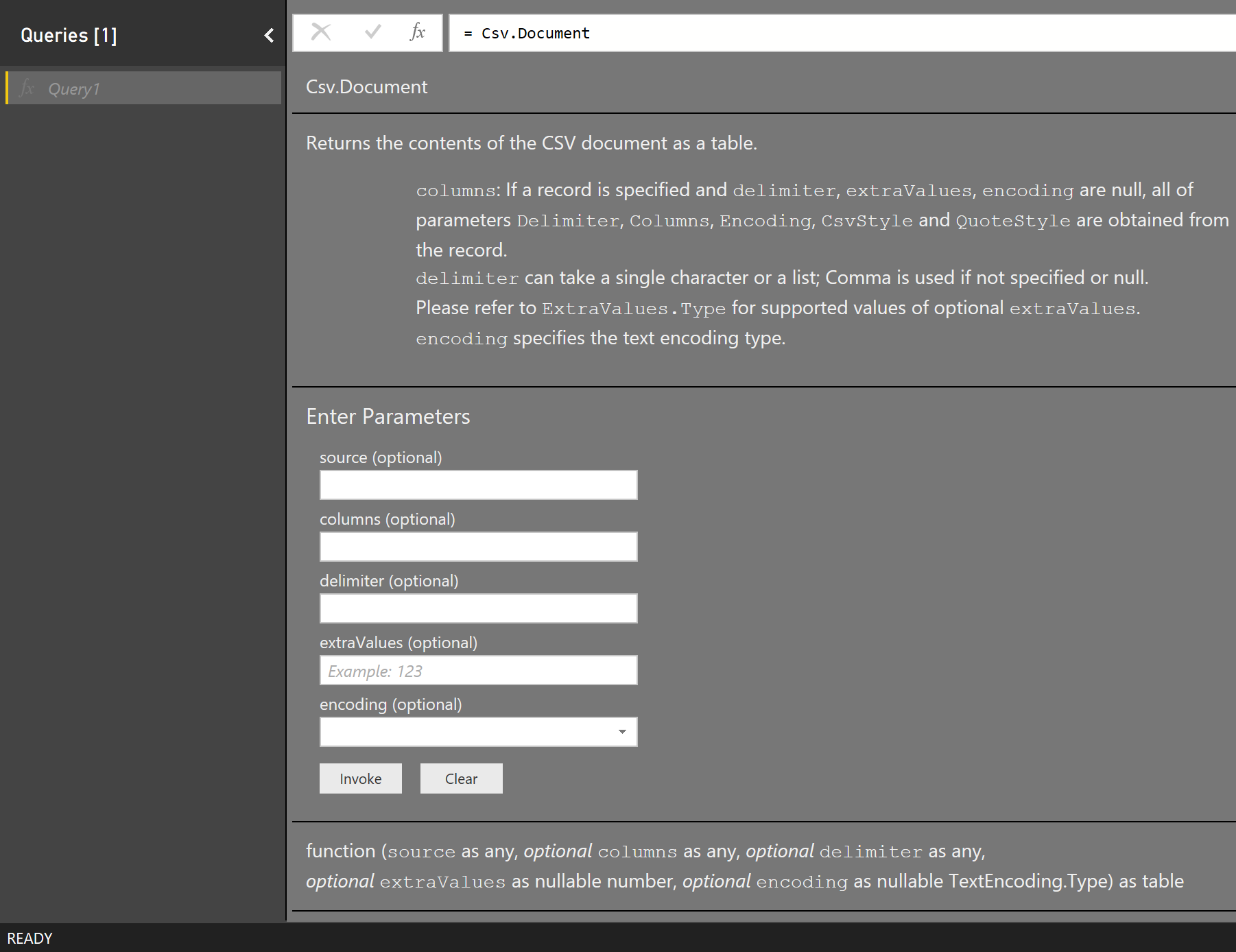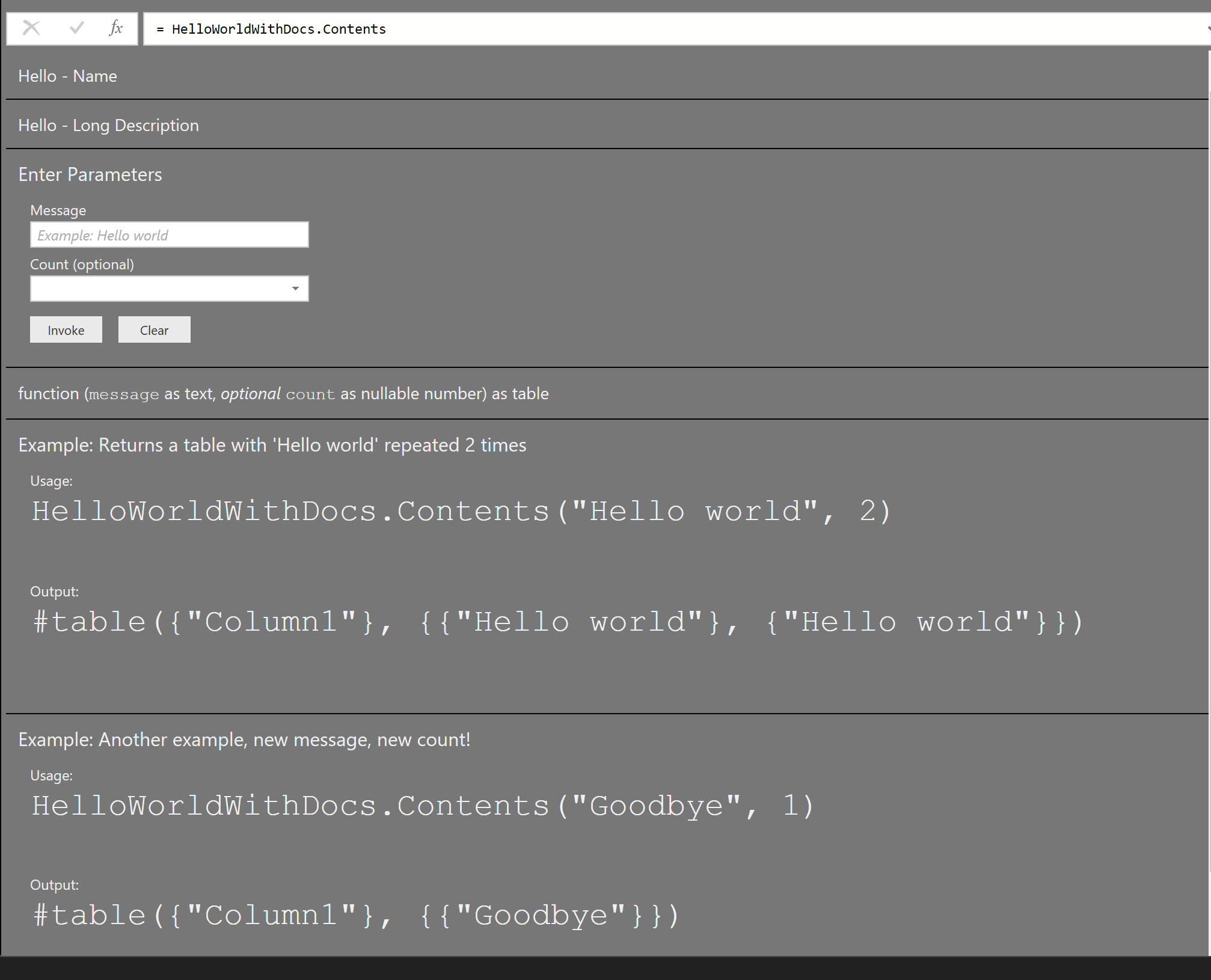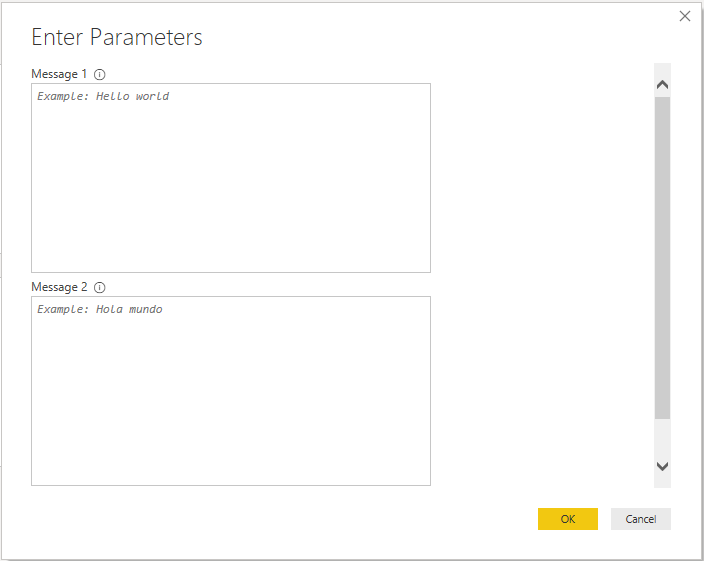添加函数文档
Power Query 会根据函数的参数自动生成调用 UI。 默认情况下,此 UI 将包含函数的名称以及每个参数的输入。

同样,在不指定参数的情况下评估函数的名称会显示其相关信息。

你可能会注意到,内置函数通常提供更好的用户体验,并提供说明、工具提示,甚至还有示例值。 可通过对函数类型定义具体元值来利用这一机制。 本主题介绍 Power Query 使用的元字段,以及如何在扩展中使用它们。

函数类型
可通过定义自定义类型值为函数提供文档。 该流程如下所示:
- 为每个参数定义一个类型。
- 定义函数的类型。
- 将各种
Documentation.*字段添加到类型元数据记录。 - 调用 Value.ReplaceType 将类型归为共享函数。
可在 M 语言规范中找到有关类型和元数据值的详细信息。
通过使用此方法,可提供函数的说明和显示名称以及单个参数。 还可为参数提供示例值,以及定义值的预设列表(将默认文本框控件转换为下拉列表)。
Power Query 体验将使用对 Value.Type、Type.FunctionParameters 和 Value.Metadata 调用组合从函数类型的元值中检索文档。
函数文档
下表列出了可在函数的元数据中设置的文档字段。 所有字段都是可选的。
| 字段 | 类型 | 详细信息 |
|---|---|---|
| Documentation.Examples | 列表 | 包含函数示例用法的记录对象列表。 仅显示为函数信息的一部分。 每个记录均应包含以下可选文本字段:Description、Code 和 Result。 |
| Documentation.LongDescription | text | 显示在函数信息中的函数功能的完整说明。 |
| Documentation.Name | text | 要显示在函数调用对话框顶部的文本。 |
参数文档
下表列出了可在函数参数的元数据中设置的文档字段。 所有字段都是可选的。
| 字段 | 类型 | 详细信息 |
|---|---|---|
| Documentation.AllowedValues | 列表 | 此参数的有效值列表。 提供此字段会将输入从文本框更改为下拉列表。 请注意,这不会阻止用户手动编辑查询以提供替代值。 |
| Documentation.FieldCaption | text | 用于参数的友好显示名称。 |
| Documentation.FieldDescription | text | 显示名称旁显示的说明。 |
| Documentation.SampleValues | 列表 | 要显示在文本框中的示例值列表(显示为淡出文本)。 |
| Formatting.IsMultiLine | boolean | 允许创建多行输入,例如在本机查询中进行粘贴。 |
| Formatting.IsCode | boolean | 设置代码的输入字段格式,通常采用多行输入。 使用类似代码的字体,而不是标准字体。 |
基本示例
以下代码片段(和生成的对话)来自 HelloWorldWithDocs 示例。
[DataSource.Kind="HelloWorldWithDocs", Publish="HelloWorldWithDocs.Publish"]
shared HelloWorldWithDocs.Contents = Value.ReplaceType(HelloWorldImpl, HelloWorldType);
HelloWorldType = type function (
message as (type text meta [
Documentation.FieldCaption = "Message",
Documentation.FieldDescription = "Text to display",
Documentation.SampleValues = {"Hello world", "Hola mundo"}
]),
optional count as (type number meta [
Documentation.FieldCaption = "Count",
Documentation.FieldDescription = "Number of times to repeat the message",
Documentation.AllowedValues = { 1, 2, 3 }
]))
as table meta [
Documentation.Name = "Hello - Name",
Documentation.LongDescription = "Hello - Long Description",
Documentation.Examples = {[
Description = "Returns a table with 'Hello world' repeated 2 times",
Code = "HelloWorldWithDocs.Contents(""Hello world"", 2)",
Result = "#table({""Column1""}, {{""Hello world""}, {""Hello world""}})"
],[
Description = "Another example, new message, new count!",
Code = "HelloWorldWithDocs.Contents(""Goodbye"", 1)",
Result = "#table({""Column1""}, {{""Goodbye""}})"
]}
];
HelloWorldImpl = (message as text, optional count as number) as table =>
let
_count = if (count <> null) then count else 5,
listOfMessages = List.Repeat({message}, _count),
table = Table.FromList(listOfMessages, Splitter.SplitByNothing())
in
table;
此代码会在 Power BI 中生成以下对话。
函数调用
函数信息
多行示例
[DataSource.Kind="HelloWorld", Publish="HelloWorld.Publish"]
shared HelloWorld.Contents =
let
HelloWorldType = type function (
message1 as (type text meta [
Documentation.FieldCaption = "Message 1",
Documentation.FieldDescription = "Text to display for message 1",
Documentation.SampleValues = {"Hello world"},
Formatting.IsMultiLine = true,
Formatting.IsCode = true
]),
message2 as (type text meta [
Documentation.FieldCaption = "Message 2",
Documentation.FieldDescription = "Text to display for message 2",
Documentation.SampleValues = {"Hola mundo"},
Formatting.IsMultiLine = true,
Formatting.IsCode = false
])) as text,
HelloWorldFunction = (message1 as text, message2 as text) as text => message1 & message2
in
Value.ReplaceType(HelloWorldFunction, HelloWorldType);
此代码(与关联的发布信息等)会在 Power BI 中生成以下对话。 新行将以文本表示为“#(lf)”或表示为“换行符”。
